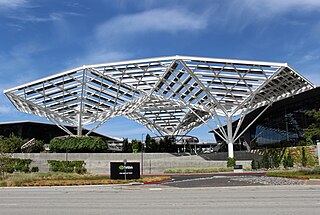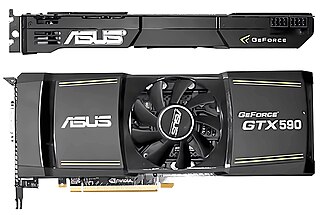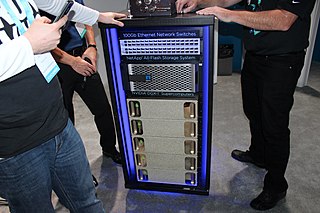
Nvidia Corporation is an American multinational corporation and technology company headquartered in Santa Clara, California, and incorporated in Delaware. It is a software and fabless company which designs and supplies graphics processing units (GPUs), application programming interfaces (APIs) for data science and high-performance computing as well as system on a chip units (SoCs) for the mobile computing and automotive market. Nvidia is also a dominant supplier of artificial intelligence (AI) hardware and software.
The Texas Advanced Computing Center (TACC) at the University of Texas at Austin, United States, is an advanced computing research center that is based on comprehensive advanced computing resources and supports services to researchers in Texas and across the U.S. The mission of TACC is to enable discoveries that advance science and society through the application of advanced computing technologies. Specializing in high performance computing, scientific visualization, data analysis & storage systems, software, research & development and portal interfaces, TACC deploys and operates advanced computational infrastructure to enable the research activities of faculty, staff, and students of UT Austin. TACC also provides consulting, technical documentation, and training to support researchers who use these resources. TACC staff members conduct research and development in applications and algorithms, computing systems design/architecture, and programming tools and environments.

The Ohio Supercomputer Center (OSC) is a supercomputer facility located on the western end of the Ohio State University campus, just north of Columbus. Established in 1987, the OSC partners with Ohio universities, labs and industries, providing students and researchers with high performance computing, advanced cyberinfrastructure, research and computational science education services.

The Irish Centre for High-End Computing (ICHEC) is the national high-performance computing centre in Ireland. It was established in 2005 and provides supercomputing resources, support, training and related services. ICHEC is involved in education and training, including providing courses for researchers.
The National Center for Computational Sciences (NCCS) is a United States Department of Energy (DOE) Leadership Computing Facility that houses the Oak Ridge Leadership Computing Facility (OLCF), a DOE Office of Science User Facility charged with helping researchers solve challenging scientific problems of global interest with a combination of leading high-performance computing (HPC) resources and international expertise in scientific computing.

POWER8 is a family of superscalar multi-core microprocessors based on the Power ISA, announced in August 2013 at the Hot Chips conference. The designs are available for licensing under the OpenPOWER Foundation, which is the first time for such availability of IBM's highest-end processors.

Fermi is the codename for a graphics processing unit (GPU) microarchitecture developed by Nvidia, first released to retail in April 2010, as the successor to the Tesla microarchitecture. It was the primary microarchitecture used in the GeForce 400 series and GeForce 500 series. All desktop Fermi GPUs were manufactured in 40nm, mobile Fermi GPUs in 40nm and 28nm. Fermi is the oldest microarchitecture from NVIDIA that received support for Microsoft's rendering API Direct3D 12 feature_level 11.

POWER9 is a family of superscalar, multithreading, multi-core microprocessors produced by IBM, based on the Power ISA. It was announced in August 2016. The POWER9-based processors are being manufactured using a 14 nm FinFET process, in 12- and 24-core versions, for scale out and scale up applications, and possibly other variations, since the POWER9 architecture is open for licensing and modification by the OpenPOWER Foundation members.

Nvidia Tesla is a discontinued line of products developed by Nvidia targeted at stream processing or general-purpose graphics processing units (GPGPU), named after pioneering electrical engineer Nikola Tesla. Its products began using GPUs from the G80 series, and have continued to accompany the release of new chips. They are programmable using the CUDA or OpenCL APIs.

NVLink is a wire-based serial multi-lane near-range communications link developed by Nvidia. Unlike PCI Express, a device can consist of multiple NVLinks, and devices use mesh networking to communicate instead of a central hub. The protocol was first announced in March 2014 and uses a proprietary high-speed signaling interconnect (NVHS).

Pascal is the codename for a GPU microarchitecture developed by Nvidia, as the successor to the Maxwell architecture. The architecture was first introduced in April 2016 with the release of the Tesla P100 (GP100) on April 5, 2016, and is primarily used in the GeForce 10 series, starting with the GeForce GTX 1080 and GTX 1070, which were released on May 17, 2016, and June 10, 2016, respectively. Pascal was manufactured using TSMC's 16 nm FinFET process, and later Samsung's 14 nm FinFET process.
Volta is the codename, but not the trademark, for a GPU microarchitecture developed by Nvidia, succeeding Pascal. It was first announced on a roadmap in March 2013, although the first product was not announced until May 2017. The architecture is named after 18th–19th century Italian chemist and physicist Alessandro Volta. It was Nvidia's first chip to feature Tensor Cores, specially designed cores that have superior deep learning performance over regular CUDA cores. The architecture is produced with TSMC's 12 nm FinFET process. The Ampere microarchitecture is the successor to Volta.

High Bandwidth Memory (HBM) is a computer memory interface for 3D-stacked synchronous dynamic random-access memory (SDRAM) initially from Samsung, AMD and SK Hynix. It is used in conjunction with high-performance graphics accelerators, network devices, high-performance datacenter AI ASICs, as on-package cache in CPUs and on-package RAM in upcoming CPUs, and FPGAs and in some supercomputers. The first HBM memory chip was produced by SK Hynix in 2013, and the first devices to use HBM were the AMD Fiji GPUs in 2015.

Summit or OLCF-4 is a supercomputer developed by IBM for use at Oak Ridge Leadership Computing Facility (OLCF), a facility at the Oak Ridge National Laboratory, capable of 200 petaFLOPS thus making it the 5th fastest supercomputer in the world after Frontier (OLCF-5), Fugaku, LUMI, and Leonardo, with Frontier being the fastest. It held the number 1 position from November 2018 to June 2020. Its current LINPACK benchmark is clocked at 148.6 petaFLOPS.
Nvidia Drive is a computer platform by Nvidia, aimed at providing autonomous car and driver assistance functionality powered by deep learning. The platform was introduced at the Consumer Electronics Show (CES) in Las Vegas in January 2015. An enhanced version, the Drive PX 2 was introduced at CES a year later, in January 2016.

Nvidia DGX is a line of Nvidia-produced servers and workstations which specialize in using GPGPU to accelerate deep learning applications. The typical design of a DGX system is based upon a rackmount chassis with motherboard that carries high performance x86 server CPUs. The main component of a DGX system is a set of 4 to 8 Nvidia Tesla GPU modules on an independent system board. DGX systems have large heatsinks and powerful fans to adequately cool thousands of watts of thermal output. The GPU modules are typically integrated into the system using a version of the SXM socket or by a PCIe x16 slot.

AMD Instinct is AMD's brand of professional GPUs. It replaced AMD's FirePro S brand in 2016. Compared to the Radeon brand of mainstream consumer/gamer products, the instinct product line is intended to accelerate deep learning, artificial neural network, and high-performance computing/GPGPU applications.
Hopper is a graphics processing unit (GPU) microarchitecture developed by Nvidia. It is designed for datacenters and is parallel to Ada Lovelace. It's the latest generation of Nvidia Tesla.
Christofari — are Christofari (2019), Christofari Neo (2021) supercomputers of Sberbank based on Nvidia corporation hardware Sberbank of Russia and Nvidia. Their main purpose is neural network learning. They are also used for scientific research and commercial calculations.

Leonardo is a petascale supercomputer located at the CINECA datacenter in Bologna, Italy. The system consists of an Atos BullSequana XH2000 computer, with close to 14,000 Nvidia Ampere GPUs and 200Gbit/s Nvidia Mellanox HDR InfiniBand connectivity. Inaugurated in November 2022, Leonardo is capable of 250 petaflops, making it one of the top five fastest supercomputers in the world. It debuted on the TOP500 in November 2022 ranking fourth in the world, and second in Europe.
















